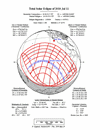- - text and links as of last publication - -
![]()
| CAUTION! OBSERVING A SUN ECLIPSE IS DANGEROUS AND MAY CAUSE IRREVERSIBLE EYE DAMAGE, UP TO BLINDNESS, ANNULAR AND PARTIAL ECLIPSES INCLUDED! Observing a Sun eclipse necessitates DEDICATED SAFE TECHNIQUES! |
This second, and last, solar eclipse in 2010, is a total solar eclipse mostly unfolding in the southern reaches of the Pacific Ocean as it will affect the islands there, beginning in the North of New Zealand! A total solar eclipse is yielding the classical, famed sight of the totally eclipse Sun, with the rays of the corona gleaming away, at greatest. A total solar eclipse occurs when the Sun is completely occulted by the disk of the Moon. for more about the solar eclipses, theoretically, see our tutorial "Sun Eclipses"
As the eclipse's greatest is occurring at 19:33:27 UT, the path of the eclipse is 160-mile (259-kilometer) wide as the eclipse is lasting 5 mn and 20 seconds only. The eclipse is beginning by about the Date Line area, about the Tongas. From there, it's heading East and reaching the area of French Polynesia, with the island of Tahiti just under the eclipse! The eclipse then will take a southeast heading, eventually reaching southernmost Chili and Argentina. The Easter Island should, too, see the total eclipse. A fine eclipse's path! For the islands in the region of the Tongas, the eclipse might well occur on July 12th, by 7 a.m. local time, due to the Date Line. Across the Date Line, the show will thus occur on July 11th, by the same local time. By French Polynesia, the eclipse should be seen about 9 a.m. local time. In Chili and Argentina, the eclipse is landing by about 15:30 p.m. and 16:30 p.m. local time respectively! Like the case for such a total eclipse, the areas either side the path of the eclipse, are having a partial eclipse. The want of lands there, however is having the public relatively rare! With locations concerned like the Kiribatis -and not Hawaii- those with a partial eclipse mostly will be located in South America, in Peru, Bolivia, Paraguay, Chile and Argentina. The closer the eclipse's path, the larger the partial eclipse! The total eclipse is seen against the constellation Gemini, the Twins with no major planet available in the vicinity, Mercury excepted, which is located in Cancer, the Crab and gibbous, at the -0.8th magnitude. The planet is not that far from the Beehive cluster (M44). The eclipse is occurring at the tropics of the south hemisphere and the south hemisphere self -where it's winter at that epoch!
 |  |  |  | Views of the July 11th, 2010 total solar eclipse as it will appear at its greatest (left) or as seen like a partial in the Kiribati, Sucre, Bolivia, or Mendoza, Argentina (following pictures, from left to right, respectively). pictures site 'Amateur Astronomy', based on Celestia (picture left) and Cartes du Ciel (other pictures) |
The eclipse's main data are the following (data as of May 1999, F. Espenak, NASA/GSFC). The Moon's apparent diameter will be of 32' 53.2", compared to the Sun's 31' 27.8". for more about how to observe a solar eclipse, see our tutorial "Observing a Sun Eclipse ":
- greatest eclipse: 19:33:27.6 UT
- eclipse magnitude (fraction of the Sun's diameter obscured by the Moon at greatest eclipse): 1.0580
- local circumstances at greatest eclipse (lat: 19° 46.4'S, long: 121° 51.6'W, elev of Sun: 47.1°; duration at greatest: 5m 20.2s)
- U1 to U4 (moments of first-last external-internal tangency of the umbra with Earth's limb; practically these are the moments of the eclipse for the places where the eclipse is total); in UT: U1 at 18:15:10.2, U2 at 18:18:28.0, U3 at 20:48:13.6, U4 at 20:51:35.1
- P1 to P4 (moments of first-last external-internal tangency of the penumbra with Earth's limb; practically these are the moments of the eclipse for the places where the eclipse is partial), in UT: P1 at 17:09:34.9, P4 at 21:57:09.2 (no P2 nor P3 are given due to that the partial eclipse, for some reaches, southeast of New Zealand, occurs when those are still in the night)
 | see a map for the July 11th, 2010 annular solar eclipse. map courtesy Fred Espenak - NASA/GSFC, as reproduced in Cartes du Ciel, Patrick Chevalley |
. for more about this eclipse and for more about solar and lunar eclipses generally, you may see at, for example, Fred Espenak's NASA Eclipse Web Site
Observation Reports: French Polynesia and the Easter Island were the locations were people observed the eclipse the most. James Cameron, the director for Avatar was present in French Polynesia where the total eclipse was seen from the Tuamotu Atolls. Hundreds of tourists were present too in Patagonia, at the tip of South America to watch the eclipse
 | the July 11th, 2010 total solar eclipse as seen like a composite mixing a solar eclipse photo with a SOHO image of the Sunís outer corona as the Moon dark silhouette was covered with a SDO image of the Sun in the extreme ultraviolet light picture courtesy Williams College Eclipse Expedition; SOHOís LASCO image courtesy of NASA/ESA; solar disk image from NASAís SDO; compositing by Steele Hill, NASA's Goddard Space Flight Center |